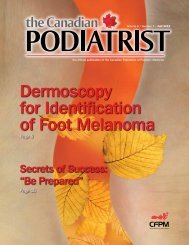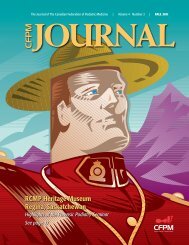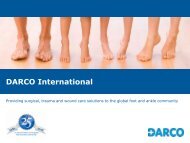Suture Workshop
Suture Workshop
Suture Workshop
You also want an ePaper? Increase the reach of your titles
YUMPU automatically turns print PDFs into web optimized ePapers that Google loves.
Jack W. Hutter DPM, C. ped, FACFAS,<br />
FAPWCA, Diplomate, ABPFAS
The earliest reports of surgical suture date to<br />
3000 BC Egypt<br />
Oldest known example of suturing is on a<br />
mummy from 1100 BC<br />
The Indian sage Sushruta described wound<br />
suture and materials in 500 BC<br />
Hippocrates described suture techniques<br />
Galen described gut suture taken from sheep<br />
intestine<br />
Lister developed techniques for sterilization of<br />
gut suture<br />
The modern era of suture begins in 1931 with<br />
polyvinyl alcohol synthetic absorbable suture<br />
Polyester in the 1950’s, polyglycolic in the 1970’s<br />
Today most suture is made of a synthetic<br />
polymer
The type of suture technique and<br />
material chosen can either compliment<br />
or hinder the surgical result<br />
Improper suture placement tissue<br />
handling can lead to painful, noticeable<br />
scarring, adhesions, dehiscence, tissue<br />
strangulation, hematoma<br />
With some specific exceptions, nondissolvable<br />
suture is used to close skin,<br />
dissolvable all else
Needle holder, forceps or Adson, Adson-<br />
Brown pick-ups, suture with needle<br />
Needles are either cutting or reverse<br />
cutting, cutting sharp on the inner curve,<br />
reverse on the outer curve<br />
Reverse cutting needles reduce the<br />
chances of the needle and suture cutting<br />
cross-ways through tissue<br />
<strong>Suture</strong> diameter and needle size vary<br />
depending upon the task
The needle holder is held with the tip of the<br />
thumb and the 2 nd , 3 rd or 4 th finger<br />
Grasp the needle with the holder at the swage<br />
(widest point, usually 1/3 distance from the<br />
suture ) of the needle<br />
The needle is fragile, easily bent or broken<br />
Stabilize the tissue edge with the pick-ups<br />
Penetrate at a 90 degree angle<br />
Grasp the passed through portion of the needle<br />
with the holder before releasing the pick-ups<br />
Pull the needle and suture through the tissue<br />
Repeat the process or tie off
Placement points for needle penetration<br />
should be directly opposite and symmetric<br />
depending upon the technique<br />
When closing skin, the suture should not be<br />
more than 3mm from the incision<br />
Wound edge inversion is to be avoided,<br />
strive for slightly everted edges<br />
<strong>Suture</strong>s placed too tightly will create a<br />
larger scar, tissue strangulation, and are<br />
harder and more painful to remove
Should not be too tight to avoid tissue<br />
constriction<br />
Should be at least a square knot, created by two<br />
clockwise twists of the needle holder around the<br />
suture and grasping the loose end of the suture,<br />
then a counterclockwise twist<br />
A “granny knot” will slip<br />
A third clockwise twist creates an even stronger<br />
“locked” knot<br />
Strangulation occurs with the third twist if the<br />
second is not securely tightened<br />
Leave adequate suture length after each knot for<br />
easier and less painful removal
Simple interrupted<br />
Simple running ( continuous )<br />
Continuous with lock<br />
Running intra-cuticular<br />
Vertical mattress<br />
Vertical mattress with pulley<br />
Horizontal mattress<br />
Simple or continuous subcutaneous<br />
Other methods of closure<br />
Modified Bunnell suture for tendon repair<br />
Ligature
Location of the incision<br />
Skin thickness<br />
How much tension is on the incision,<br />
potential for swelling<br />
Creation of dead space<br />
Cosmetic result ( reduced scarring )
Linear<br />
-Straight, uncomplicated, no<br />
angular correction<br />
Curvi-linear ( semi-elliptical )<br />
-Used to accommodate tissue<br />
irregularity, angular correction<br />
Converging semi-ellipitical<br />
-Excision of lesion, tissue<br />
redundancy<br />
Lazy “S”<br />
-Used where a large amount of<br />
exposure is desired, reduced<br />
tension on skin edge<br />
” V- Y”Advancement<br />
-Lengthens skin contracture<br />
Teardrop<br />
-Derotational incision
SIMPLE INTERRUPTED<br />
PRO<br />
-Easily placed<br />
-Good wound edge strength<br />
-Less tissue strangulation<br />
CON<br />
-Minimal edge eversion<br />
-Time consuming to place<br />
-Noticeable train – track scar<br />
possible if left in too long<br />
or too tight
SIMPLE CONTINUOUS ( RUNNING )<br />
PRO<br />
-Less knots, thus quicker to<br />
place and less scarring<br />
-Good for long incisions<br />
CON<br />
-Tissue strangulation if too<br />
tight, with dehiscence<br />
-Avoid if tissue is hypovascular
SIMPLE CONTINUOUS LOCKED<br />
PRO<br />
-Increased strength, used in<br />
cases where there is great<br />
tension on the incision<br />
anticipated<br />
-Reduced slippage of the suture<br />
line<br />
-Quickly placed as is similar to<br />
the simple continuous except<br />
with a doubling back under<br />
the suture loop<br />
CON<br />
-Micro vascular impairment<br />
-Increased risk of dehiscence
CONTINUOUS ( RUNNING ) INTRACUTICULAR<br />
PRO<br />
-Usually done with dissolving material,<br />
doesn’t need to be removed<br />
-Improved cosmetic result if done<br />
properly<br />
-Placed within the epidermis, results in<br />
less scaring and no RR tracks<br />
CON<br />
-Less eversion of edges if done<br />
improperly, resulting scar will be<br />
more noticeable<br />
-Time consuming<br />
-Too much material, will contribute to<br />
scar hypertrophy from increased<br />
tissue reaction<br />
-Increased skin tension can lead to<br />
gapping
VERTICAL MATTRESS<br />
PRO<br />
-Good edge eversion<br />
-Dead space closure<br />
-Quickly done<br />
-Less strangulation if<br />
combined with intermittent<br />
simple interrupted sutures<br />
CON<br />
-Strangulation if excessive<br />
swelling<br />
-RR tracks due to four access<br />
points
VERTICAL MATTRESS WITH CINCH ( PULLEY )<br />
Same PRO’s and CON’s as<br />
with vertical mattress<br />
except allows for even<br />
greater closure strength,<br />
but also increased risk of<br />
strangulation depending<br />
upon the amount of<br />
swelling
HORIZONTAL MATTRESS<br />
PRO<br />
-Good if high wound tension,<br />
swelling<br />
-Good edge eversion<br />
CON<br />
-If placed too tightly, there is<br />
increased risk of<br />
strangulation and<br />
dehiscence<br />
-More painful to remove due<br />
to double stranded throw
SIMPLE INTERRUPTED AND CONTINUOUS SUBCUTANEOUS<br />
PRO<br />
-Layer closure of subcutaneous<br />
tissue<br />
-Usually dissolvable suture<br />
material<br />
- Interrupted for small space,<br />
continuous for larger<br />
-Closes dead space<br />
-Reduces tension on skin<br />
incision<br />
CON<br />
-Strangulation if too tight<br />
-Increased suture reaction,<br />
dehiscence, “ spitting of knot”
Steri-strips<br />
-Good as a bolster when combined with other suture<br />
methods<br />
-Reduced scarring<br />
Staple<br />
-Not used in foot surgery very much<br />
Adhesives<br />
-Dermabond<br />
-Similar to superglue ( cyanoacrylate )<br />
-Not as strong as suture, used as a skin bolster<br />
combined with traditional suture<br />
-Little scarring<br />
-Rapid healing<br />
-No suture removal
Used in tendon repair,<br />
“Z” -plasty tendon<br />
lengthening<br />
A combination of<br />
horizontal and vertical<br />
mattress<br />
Number of suture throws<br />
increases strength
In foot surgery, primarily vascular<br />
Venous, arterial bleeders<br />
Instrument or hand tie, square knot<br />
Bovie electrocoagulation
Thank you
















